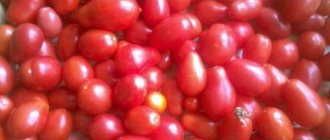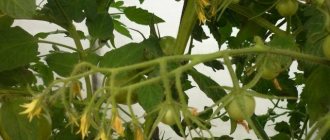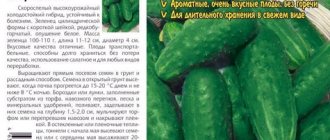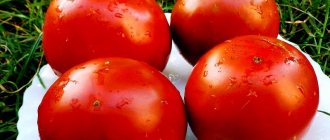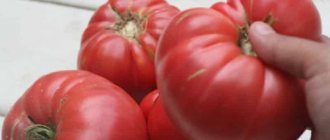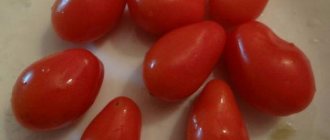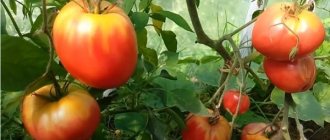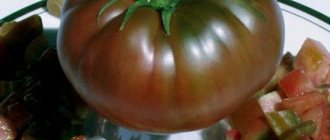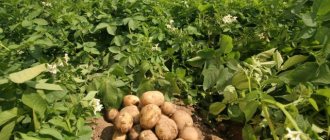The Cascade tomato variety is productive, as confirmed by photos and reviews from summer residents, is undemanding to care and has many advantages. In appearance, the Cascade tomato has a traditional tomato shape, the leaves are ordinary green. During the flowering period, flowers are formed, then ovaries.
The Cascade tomato is an indeterminate variety and produces medium-sized fruits. From photos and reviews from gardeners, it can be seen that tomatoes have high yields, sprout quickly, and up to 20 or more ovaries are formed in one bush.
Characteristics and description of tomato
The Cascade tomato variety is a common mid-season vegetable that ripens in 110-115 days. The plant is an indeterminate plant; its growth can reach up to 1.5 m, so you should take care of the planting site and prepare supports in advance.
Thanks to the well-developed root system and the strength of the stem, a single bush can be formed when planted. But if necessary, it is allowed to connect up to 3 sprouts.
Tomato productivity is high. With proper cultivation and following basic care rules, it is possible to get a good turnover of vegetables per 1 m2. Up to 25 fruits can form on one bush.
The fruits of the Cascade tomato variety are bright red, smooth with juicy, fleshy pulp. The peel is of medium thickness and protects the tomatoes from mechanical stress. The taste is sweet with slight sourness. Therefore, the vegetable is used in the preparation of many dishes, including for fresh consumption.
Due to the plant's unpretentiousness and resistance to adverse conditions and diseases, tomatoes can be grown both outdoors and under cover. To prevent the tomato from being crowded, no more than 4 bushes should be placed per 1 m2.
Due to their unusual appearance and regular shape, tomatoes are also used for table decoration and are great for pickling and salads.
They don’t really need any care, you just need to tie up, water, weed and loosen the soil in a timely manner, then a rich harvest of Cascade tomatoes is guaranteed.
Interesting! The fruits can reach a weight of up to 100-150 grams, depending on the area of growth and the choice of soil.
Tomato Cascade: variety description, photos, reviews, characteristics, yield
The Cascade tomato is a product of Russian selection, intended for cultivation in areas with an unstable climate. The qualitative characteristics of the variety attract not only farmers, but also cooks and nutritionists.
Description of tomato variety Cascade with photo
The originator of the selection is considered to be the Agros company. According to the recommendations of experts, the tomato is well adapted to growing in areas with short summers. It can be planted in Siberia, the Far East and the Urals under cover. In the southern regions, vegetable growers practice open-air planting. The Cascade tomato has been included in the State Register since 2010
The plant is indeterminate. Vegetable growers need to shape the bush to limit its development. The tomato itself does not stop its growth, as happens in determinate species.
External parameters of the Cascade variety:
- The bush is tall but compact. An adult plant reaches a height of 1.5-1.7 m. Without tying and shaping, growing a Cascade tomato will be very problematic. It is recommended to grow the plant with 1 main stem and 2-3 additional ones.
- The root system is well developed.
- The stems of the Cascade are powerful and durable, the foliage is average. They can withstand a large harvest with dignity.
- The inflorescence belongs to the complex raceme type. The number of fruiting clusters is large (more than 5 pieces). One bunch is formed from 25 oblong-shaped tomatoes.
- The leaves are tomato-type, alternate, and medium in size. The color of the foliage is light green, the surface of the plates is covered with fluff.
Larger tomatoes ripen on the first bunches. The Cascade variety is undemanding to growing conditions, but performs better in greenhouse areas.
The description states that it is intended for sowing under cover. The photo shows the Cascade tomato variety:
When properly formed, the variety grows very compactly
Description of fruits
Cascade tomatoes have a very original appearance and are distinguished by quality characteristics.
Basic fruit data:
- The shape is plum-shaped, with a spout at the end of the vegetable. Lightly ribbed tomatoes resemble a small cylinder.
- The weight of one Cascade tomato is about 100 g. The first tomatoes are larger, the rest weigh a little less.
- The color of unripe tomatoes is green, while ripe ones are deep red.
- The taste is sweet with slightly sourness. The fruits also have a pleasant tomato aroma.
- The pulp is dense, elastic and juicy. There are 3-4 nests inside, few seeds.
- The peel is medium thick, smooth and dense. Well protects fruits from damage during transportation. It also allows you to store the crop for a long time and prepare it for the winter. The skin does not burst during heat treatment.
Cascade tomatoes are very beautiful in appearance. They have the correct shape, intense color, and small size. Such parameters attract not only vegetable growers, but also culinary specialists.
Compliance with agrotechnical requirements guarantees uniform, rich coloring of fruits
Characteristics of the Cascade tomato
The original description of the variety states that it can be grown outdoors.
The variety's good resistance to changes in external conditions allows vegetable growers to get a harvest without shelter, although the originators recommend planting the Cascade tomato in greenhouses (film or glass).
The main characteristics of the variety are manifested when agricultural cultivation techniques are observed. In this case, summer residents can definitely expect from the Cascade:
- good yield;
- quality taste;
- decent presentation;
- disease resistance;
- a large number of healthy dishes.
In addition, the Cascade variety is highly valued for its ability to withstand transportation without damage.
Cascade tomato yield and fruiting
Harvest ripening period is mid-early. The fruits can be harvested 90-100 days after the seeds germinate. From 1 sq. m, gardeners harvest up to 7.5 kg in a greenhouse and about 5.0 kg of ripe tomatoes in open beds. From one bush - 3.5 kg. The formation of the bush affects the yield; it should be maintained in 1 main stem. Also, the number of fruits depends on the timeliness of pinching.
Already in the early stages of fruit ripening, the future result is visible
Area of application of fruits
The original shape and small size of the fruits of the Cascade variety attract culinary experts. The dense consistency and durable skin allow Cascade tomatoes to be used for whole-fruit canning. Great taste - for salads or slices. The juicy pulp is suitable for making rich juice, sauce or paste. The vitamin composition is suitable for dietary nutrition.
Resistance to diseases and pests
The variety resists well the main crop diseases and is rarely affected by pests. However, violations of care and agrotechnical recommendations can lead to failures. Then the bushes will be susceptible to fungal infections.
Pest and disease control
Tomato resistance to crop diseases is quite high. But if agricultural cultivation practices are violated or unfavorable weather conditions last for a long time, a fungal infection may develop on the bushes. In this case, the plantings are affected by late blight or blackleg. Infected bushes must be removed and burned. Treat the rest with Quadris, Ecosil, Fitosporin, Fundazol.
Plants can be attacked by aphids and spider mites. If there are potato plantings nearby, the Colorado potato beetle may come. Insecticide treatments will help; the beetle can be collected by hand.
Conclusion
The Cascade tomato is a universal variety that can be grown in different regions. Following the rules of planting and growing will allow you to get a good harvest in a greenhouse or in open ground. Unpretentiousness and productivity are the main qualities for which vegetable growers choose a variety for their plots.
The Cascade variety will meet all expectations. It is not often grown commercially. But for home use, the tomato is very good. Taste, keeping quality, original shape of the fruit - the combination of these parameters has made the tomato very popular. Easy care. 2-3 feedings are enough, remove the stepsons and form the stem. Any vegetable grower can handle this.
2 Radishes
Garden online magazine
Adblock detector
Source: https://2rediski.ru/tomat/kaskad/
Advantages and disadvantages
The Cascade tomato variety is widespread, which is explained by its many advantages and almost complete absence of disadvantages. Regardless of the height of the bush, if you properly tie up and mulch the seedlings, care is carried out without difficulty. But some gardeners attribute growth to minor shortcomings of the vegetable.
Among the advantages of tomatoes are:
- High yield.
- Abundant formation of fruits on one bush.
- Cascade tomatoes can be grown both in a greenhouse, hotbed, and in open ground.
- The fruits have excellent taste, so they are widely used in the preparation of many dishes, for fresh consumption and for winter preparations.
- Cascade tomatoes are not particularly demanding in growing and caring for; it is enough to carry out traditional care measures and a rich harvest is guaranteed.
- The plant is characterized by some resistance to major diseases.
- Tomato fruits have an unusual, unique color, so they will look great as a holiday table decoration.
Features of agricultural technology for garden crops
It is rational to grow tomato Cascade using seedlings. Plant seeds 60-65 days in advance. before transferring the seedlings to the soil of the garden or greenhouse. The full cycle from germination to the first ripe fruits is 105-115 days. Plant no more than 3-4 bushes per 1 square meter. m. The exact amount depends on air access to the greenhouse or garden bed, as well as your personal experience in growing various crops in a particular area.
Other nuances of tomato cultivation:
- The plant shows the best results when formed into 1 stem;
- delete all subsequent stepsons;
- install trellises immediately after planting seedlings;
- tie the whip in several places as the fruit sets.
Soil preparation
The choice of soil in tomato cultivation is of great importance. It is believed that this vegetable is quite demanding on the soil; it must be light, breathable and fertile. It is better to choose sandy loam soils for planting Cascade tomatoes. It is also important to pay attention to the acidity of the soil. They should not exceed 6.5.
The soil for tomatoes has been prepared since autumn. At this time, apply all the necessary fertilizers and carefully dig up the soil for the winter. Among fertilizers, both mineral and organic fertilizers are used. This can be cow manure, chicken manure, compost, you can also use wood ash, superphosphate and other components.
In the spring, when many vegetables are being planted, the area for tomatoes should be dug up again and, if necessary, the soil should again be enriched with fertilizers. This will ensure the friendly growth and development of the tomato, and will prevent the plants from being damaged by diseases.
Note! Planting a Cascade tomato variety can be done in an area where onions and cabbage previously grew. Avoid soils in which peppers, eggplants and potatoes grew. If there were already tomatoes in this place last year, tomatoes can be planted in this area, but the soil should be thoroughly enriched.
Features of cultivation
Growing the Cascade variety is no different from growing other tomato varieties.
Planting seedlings
It is recommended to plant the cascade with seedlings in the ground. To do this, seeds are sown in early March. They must be prepared in advance for planting in order to get a good harvest in the future. The seeds are placed in a saline solution for 20 minutes to reject bad grains. To do this, dilute a spoonful of salt in a liter of water. The seeds are placed there. Those that float to the surface of the solution are rejected. They are hollow and will not produce a harvest. Everyone who has sunk to the bottom is planted.
But before planting, it is also necessary to disinfect the seed material. To do this, place it for 10 minutes in a weak solution of potassium permanganate. Then the grains are washed under running water and lightly dried on a paper napkin. To make it easier to carry out all these manipulations, the seeds are wrapped in a bandage or gauze.
Then prepare fertile soil for planting. It is necessary to mix 4 parts of peat with one part of river sand and turf. All components are mixed, the soil is placed in pots and the seeds are planted in it to a depth of 0.5-1 cm. The grains are covered with a thin layer of soil and watered.
The pots are covered with film and placed in a warm place. As soon as the sprouts appear, the film is removed and the seedlings are placed on the windowsill in a sunny place.
Once a week, the seedlings are watered with settled water using a pipette.
As soon as 3 true leaves appear on the seedlings, pick. To do this, each plant is planted in a separate, larger container. In such pots, seedlings grow before being planted in the ground.
Landing in the ground
As soon as 5-7 leaves appear on the seedlings, you can start replanting them in the ground. It is advisable to choose sandy loam soils. It is also worth paying attention to acidity. It should be within pH 6.5.
Before planting seedlings in the garden bed, it is necessary to apply organic fertilizers and thoroughly dig the soil. This will provide the plants with all the necessary nutrients.
It is recommended to choose beds where cabbage and onions previously grew. You should not plant in beds where potatoes, peppers, and eggplants previously grew.
Holes 5-7 cm deep are dug along the perimeter of the entire bed. Plants are planted so that the lower leaves are above the surface of the ground. Maintain a distance of 30 cm between plantings. After planting the plants, water them. The seedlings are covered with film. It is removed only during the daytime, in sunny weather. You can completely remove the film from the garden bed at the beginning of July.
Sowing tomato seeds for seedlings
It is necessary to plant tomato seeds approximately 60-65 days before the expected day of planting seedlings in open ground. For mid-season tomato varieties, sowing begins approximately in the beginning or middle of March in order to transplant the seedlings in the first ten days of June.
The planting material is processed before planting and it is advisable to carry out a check to obtain maximum germination of the plants.
The check is carried out as follows:
- Water is poured into a glass.
- The seeds are dropped into it.
All floating seeds are removed, and those remaining at the bottom are dried and used for planting.
You can also soak the seeds in a weak solution of potassium permanganate to disinfect them and increase immunity to blackleg and other diseases.
Interesting! Special growth agents will help speed up the germination of tomatoes. Plant the tomato in pre-prepared containers with soil. You can prepare the substrate yourself or purchase it at the store.
Small furrows are made in the prepared soil and the seeds are sparsely immersed in them. The soil is first moistened with water at room temperature. After planting, you can again not water the soil abundantly.
In order for the sprouts to sprout faster and more quickly, the containers can be wrapped in polyethylene to retain heat, optimal humidity and temperature. With the appearance of the first bores, the film is removed and the seedlings begin to be prepared for the street, gradually hardening them.
Note! Containers for planting seeds must have small holes to allow air exchange.
Diseases
Late blight
This is a fungal disease that affects tomato bushes and fruits. Dark spots appear on the leaves and stems, which quickly spread throughout the plant and affect the fruits. Over time, the bushes and tomatoes completely rot. Most often, the disease is provoked by rainy weather or sudden changes in temperature.
Infected plants must be removed from the garden bed and burned. All other bushes are treated with preparations such as Fitosporin, Bordeaux mixture, Ecosil, Quadris.
Blackleg
This is a fungal disease in which the stems of plants begin to rot and become thin. As a result, the bush cannot develop and dies. When this disease appears, it is necessary to treat tomatoes with the following compounds: Fundazol, Trichopolum. It is also important to regulate the watering of plants.
Transplanting seedlings into the ground
After the seedlings have grown sufficiently, become stronger and become accustomed to low temperatures, they can be transplanted into open ground. It is believed that this procedure is done when at least 6 leaves have formed on the tomato bores.
As for the time, the plants are replanted in early June, when the weather is warm and there are no night frosts. In the case of replanting in a greenhouse, this can be done a little earlier, around mid or late May.
Transplantation of tomato seedlings of the Cascade variety is carried out according to the following scheme:
- Shallow holes are made along the perimeter of the site, keeping a distance of at least 30 cm from each other, and 0.5 m between rows.
- The holes are moistened with water and the seedlings are immersed to almost half the length of the stem.
- The top of the hole is sprinkled with dry soil and watered again.
Important! It is necessary to transplant tomato seedlings in clear sunny weather.
Reviews
Lyudmila from Perm was disappointed with the tomato. On a simple brush, 8-10 tomatoes grew on her greenhouse bushes. The woman was not satisfied with the size or taste. But other reviews are mostly positive.
We invite you to read: Miscanthus planting and care in open ground
A pensioner from Irkutsk (nickname Lapushechka) notes the intensive growth of seedlings. Alinara from the same city boasts of her harvests. Her tomatoes ripened within 100 days. Therefore, they can be classified as mid-early. 7-9 brushes grew on the bush, and each had about 20 pieces. tomatoes. They all turned out to be equal in size and weighed about 90 g.
The Cascade tomato is a good example of a high-yielding variety. It also has disadvantages, but with proper cultivation they can be minimized.
Vasilisa
Cascade tomato care technique
Care is an integral part of a rich harvest, and Cascade tomatoes also need it. In order for there to be a lot of fruit at the end of summer and the plants not to die from diseases and pests, it is necessary to weed the beds, loosen the soil, form bushes, properly water and fight diseases and pests.
Tomatoes should be watered as needed at a rate of 1 liter per hole. In rainy weather, moisture is eliminated or reduced, and in hot weather, on the contrary, it is increased. More abundant watering should be carried out during the flowering of the bushes and when the fruits are forming. Water for irrigation should be at room temperature, avoid ice water and water the plants only under the root system.
After watering, it is recommended to weed the beds and loosen the soil. Tomatoes are tied depending on their growth. If necessary, the bushes are boiled. For convenience and power, one bush is formed from 2-3 sprouts.
It is also necessary to feed tomatoes with organic and mineral fertilizers about 3 times throughout the summer. An excellent option are magnesium, potassium, nitrogen and phosphorus compounds; in addition, you can use wood ash, superphosphate and diluted manure for watering.
Diseases and pests are fought with the help of special preparations that are sprayed on the bushes. It is also allowed to use folk techniques, for example, spraying tomato leaves with decoctions of fragrant herbs (dill, wormwood, garlic).
Growing and care
The bush is grown with 1-2 stems, but up to three are allowed. They are tied to supports.
Watering once a week in the morning or evening is enough. The water is slightly heated, trying not to wet the stem and foliage. Then they loosen the soil.
Feed at least three times. Young bushes benefit from manure and wood ash. At the stage of fruit ripening, mineral fertilizers with potassium, phosphorus and other microelements are required. This will improve the taste of the tomatoes.
To prevent blossom end rot, fertilize with calcium.
Diseases and pests
Tomatoes, like other vegetables, are quite often exposed to various diseases and pests, so they also need to be controlled and properly cared for. Tomatoes are often affected due to failure to follow simple growing and care rules.
The Cascade tomato variety itself has significant resistance and immunity to major dangerous diseases. But if the care technique is violated, the plant can be affected by late blight, various forms of rot, black leg, spotting, mosaic and other diseases. All of them have a detrimental effect on the growth and development of the bush, and interfere with the normal formation of fruits. Often diseases completely lead to the death of plants.
Among the pests that also negatively affect the development of vegetables, the most common are mole crickets, wireworms, aphids, and less often slugs, mites and other insects.
Important! In order to preserve the tomato harvest as much as possible and prevent dangerous diseases, it is necessary to carry out preventive measures and properly care for the plantings.
Features and details of the variety description
Tomato Cascade is a very productive variety. The bush reaches a height of 1.5-1.7 m, the leaf is an ordinary tomato, medium in size. During the ripening phase, the plant is densely covered with fruiting clusters. One of these can grow up to 24-25 oblong tomatoes. The photo shows that they sing together and are approximately the same size. The taste characteristics are good.
The variety was registered by the Novosibirsk company Agros. It is adapted to the short summer of Siberia, the Urals, and the Far East. It is also grown in warmer regions. Breeders recommend planting this tomato in temporary greenhouse structures.
According to ripening time | By type of growth | By type of use | By growing method | Fruit weight (g) | Productivity (kg/m2) | Ripe fruit color | Fetal characteristics |
| Mid-ripe | Indeterminant | Salad | For film greenhouses and greenhouses | 90-100 | 10-14 | Red | Cylindrical shape, sometimes with small ribs, contains 2-3 cavities |
Pests
Aphids spread at lightning speed. It first affects the lower part of the leaves and then spreads throughout the plant. By sucking out its juices, it leads the bush to death. To destroy the pest, it is recommended to use drugs such as Karbofos, Actelliak, Aktera, Tanker.
Spider mite
The tick secretes a special secretion, forming a web. If the plant is slightly damaged, it can be saved. Therefore, at the first signs of the appearance of a pest on the bushes, it is recommended to treat with Actellik, Ethisso, Fitoverm.
Tags: stuntman, tomato
About the author: admin4ik
« Previous entry
